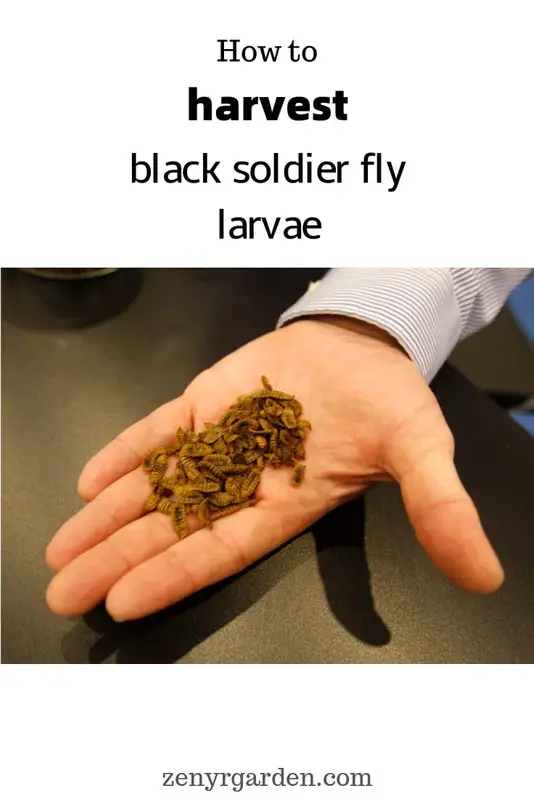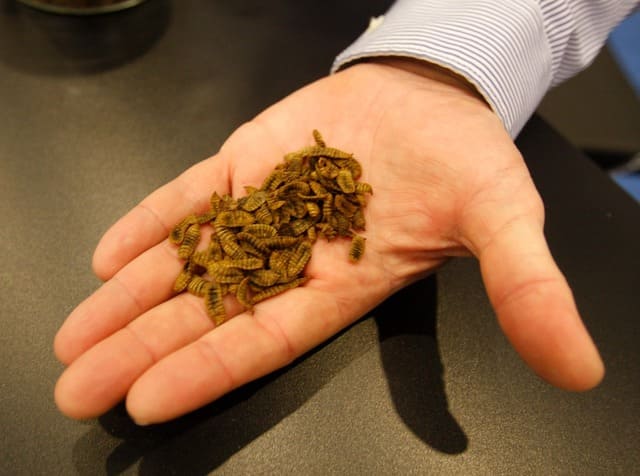One major part of harvesting black soldier fly larvae is the sifting out of the larvae & the frass. The frass is basically the remaining mixture of undigested foods, the exoskeletons of the larvae and their poop. There are some ways to harvest them to get a higher-quality products. Together, let's check them out now.
Here are some steps to harvesting BSF, one of which growers usually begin with:
Filtering Out Castings in a Runny Food Bed
If the food bed that the larvae have been feeding on is quite runny & wet, it's usually a bit harder to separate out the larvae poop compared to a more dry food bed.
In this case, you can take the whole mix (larvae + their food + their casting) and place it in a kind of mesh bag or a muslin bag like cheesecloth. Wash the bag under running water. The liquid substrate + their poop should all be flushed out.
Cool water is better because while eating in a concentrated area, the larvae generate quite a lot of heat already. The downside to this filtering method is that it can be quite heavy to carry a whole bag of wet substrate & larvae. And we may not be able to collect the frass for further utilization. You can place a bucket or container underneath to catch the liquid frass.
Another way you can try is to dry it out with air for 3-4 days. When the substrate is dried, it will be very easy to filter. The pieces will fall out like crumbled soil. You can hook a fan near-by for drying or just let the wind do its job.
In another case, if your BSF substrate is more dry, then we can move on to:
Sifting 15-day-old Larvae
If your larvae mix is more dry, you can sieve it directly without the need of flushing water out. You can use a manual shaking sifter. A 3mm mesh screen is good for this job.
For an automatic sifter, a mesh screen of 5mm is suitable. Because the machine can shake more times per minute, the larvae on this shaking screen won't be able to move & fall through. The bigger openings help you separate out the pieces faster.
After Sifting the Larvae
After you sifted the larvae out, place them in a dry, clean material like sand or sawdust. This helps clean their skins & gives them time to clean their guts.
They'll not be eating anything more at this point. This is the point where they pack the most energy (nutrition) in their bodies. Placing the harvested larvae in sand for a few days gives us a higher-quality end product.
After that, you can ship them live to farmers near by in dirt bag or box. Or use the larvae to directly feed your fish, chickens or pets.
To see how to pack your BSF egg box for selling, you can check out this post later:
If you're harvesting the larvae for resale, you may need to do some weighing & counting. Let's see some ideas for that next.
Weighing & Counting the Larvae
If you harvest the larvae to sell to other people, then the next step is to weigh them.
On average, the weight of the larvae over the 2-week growing period may be a bit like this:
| Larvae stage | Average weight (grams) | Length |
|---|---|---|
| 5 days old | 0.0012 | - |
| 10 days old | ~0.0625 | - |
| 15 days old | 0.125 | 1/8 - 1 inch (0.3-2.5 cm) |
If you're harvesting the larvae at about 10 days old, then in 5 grams there will be about 80 BSF larvae. If you sell larvae by the thousand, then to get about 1000 larvae you can measure out about 62-63 grams of larvae (with the residue frass sifted out).
While you're growing your larvae, remember to do some:
Bi-Weekly Sifting
For very young larvae about 3 days old, it's very difficult to filter out their poop. So some growers just let them grow in it as in some cases (like on cold days) the unfiltered poop can help keep them warm.
When they're about 5 days old, it's good to sift the poop or the frass out from the larvae. This helps reduce the heat issue & increase the survival rates of the larvae according to some growers.
For this maintenance task, you can scoop everything in the growing area into a mountain-like pile. After a while, the larvae will naturally climb downhills to find their food. The stuff on the top is the frass that we can scoop out. We can repeat this process 1 or 2 times to make sure no living larvae is accidentally scooped into the screened out frass pile.
Once you've collected the larvae, a question many people ask is what can we do next with their frass? Let's check out some ideas for:
Using the Frass & Larvae Poop
BSF larvae poop is a great source of nutrients for red worms, red wigglers or the little creatures in vermiculture. It's a great addition if you have a vermiculture system running together with the BSF raising.
Also, the frass can be utilized as a plant fertilizer. To use the poop & frass, some people advise that it's better to mature it a bit further for 1-1.5 months just to be safe. If we put the frass in the soil too soon, the microbial activity in the frass may be high and it could compete with plants near by, thereby stunting their growth. Another way to use frass is we can feed these to catfish, chickens, quails, shrimps. It's completely smell-free.
The liquid that we may get out from the runny substrate works great to deter houseflies or other wasps. When the little BSF larvae eat, they excrete out some sort of pheromones. Once they get more crowded, the concentration of these pheromones in the air gets higher. Getting some of this juice can help you attract female black soldier flies naturally from a wild environment to grow your colony.
Have a Good Egg Harvest
As you can see, harvesting BSF larvae is not extremely difficult business. Make sure to keep the poop stuff out of the larvae & you're basically good to go. Also, if your harvesting substrate that is wet, let it air dry or wash the liquid out.
It does make us wonder that as BSF larvae can decompose other animal manure like chicken manure, they don't seem to break down their own... manure you know what I mean. Hope you'll have a good harvest. Thanks for visiting & See you next time!
Share or pin this post!


